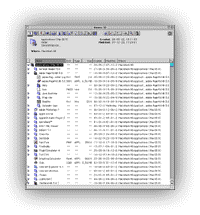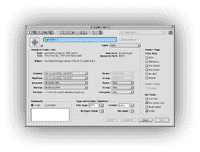|
<< back to articles
Classic Mac Recommandation: File Buddy
Jan 21st 2024 (Kriss-André Jacobsen)
If there's one thing classic Mac OS is missing, it's a decent
file manager. Finder does the basic stuff, but not much more
than that. In fact, Finder lacks the ability to do many of the
the basic tasks, like show hidden files, change file type, change
default application for a particular file, to name a few things.
File Buddy let's you do all that, and more. The latter two things
is particularely important, as file types works quite differently
in the classic Mac OS world than what we're used to today.
Let me explain. Today we're used to file extensions (.jpg,
.html, .txt, etc.) to define what type a file is. But in the
world of classic Macintosh, this information, as well as which
application should be used to open a file, was stored in an extra
data stream of the file (the resource fork), instead of in file
itself. Each file has two four-letter codes assigned to itself.
The Type-code and the Creator-code. The type code
determines which file type it is. For example, a jpeg picture
has the type code JPEG. A Word-document, which we usually know
as .doc or .docx, has the type code W8BN. I have no idea
why. These codes are not shown in finder. In addition, each file
has a Creator-code assigned to it. This code determines which
application that originally created the file, and thus telling
Mac OS which app to open the file when double cliked. A jpeg
created with Adobe Photoshop will have the creator code 8BIM,
while a jpeg created with QuickTime Picture Viewer will have
the creator ogle. This means, that you probably already
have guessed, that the same type of file can have different default
applications. Coming from he modern world, where everything is
determined by some letters in the file name, this is quite confusing
if you're not used to it. File Buddy will of course let you change
these properties in batch, so you easily can determine yourself
which apps should open your favorite files.
But it doesn't stop there. These codes works slightly different
on one particular type of files: Applications. For applications,
the type code is always APPL. You can think of this as
.exe on Windows, or .app on modern Mac OS. The creator code determines
the app's unique identity, which is then used during file assignment.
So the Photoshop application has the creator code of 8BIM, and
the type code of APPL. And all files with the creator code 8BIM
wil open in Photoshop. Does this make sense? I didn't think so.
But
you can read more about it on Wikipedia.
 In
addition to this, each file can consist of two data streams,
the Resource Fork and the Data Fork. While the
data fork contains the file itself, the resource fork contains
optional data, meta data, the mentioned above creator- and type
codes, and other additional info. If for example a picture contains
a thumbnail, the thumbnail is stored in the resoruce fork, while
the picture itself is stored in the data fork. For SimpleText
documents, the text is stored in the data fork (as plain old
TXT), and all formatting is stored in the resoruce fork. You
can read more about this on Wikipedia as well. There is one
big problem with this approach: most file systems don't support
multiple data streams for a single file. So copying a Mac file
to Windows or Linux, will strip the file for it's resource fork.
For some file types, like MP3 or Jpeg, tis isn't really a problem.
But for classic Macintosh application, which stores big portions
of the application data in the resource fork, it means that the
entire application is corrupted if copied to another operating
system. To deal with this, there were tools that could combine
both forks into the data fork so the file could be shared online,
on email, on PC floppy disks, etc. Then you used the same tool
to split the file up correctly when it was safely back on a Macintosh. In
addition to this, each file can consist of two data streams,
the Resource Fork and the Data Fork. While the
data fork contains the file itself, the resource fork contains
optional data, meta data, the mentioned above creator- and type
codes, and other additional info. If for example a picture contains
a thumbnail, the thumbnail is stored in the resoruce fork, while
the picture itself is stored in the data fork. For SimpleText
documents, the text is stored in the data fork (as plain old
TXT), and all formatting is stored in the resoruce fork. You
can read more about this on Wikipedia as well. There is one
big problem with this approach: most file systems don't support
multiple data streams for a single file. So copying a Mac file
to Windows or Linux, will strip the file for it's resource fork.
For some file types, like MP3 or Jpeg, tis isn't really a problem.
But for classic Macintosh application, which stores big portions
of the application data in the resource fork, it means that the
entire application is corrupted if copied to another operating
system. To deal with this, there were tools that could combine
both forks into the data fork so the file could be shared online,
on email, on PC floppy disks, etc. Then you used the same tool
to split the file up correctly when it was safely back on a Macintosh.
So what does File Buddy have to do with all of this? Well,
it let's you see and manipulate the files for what they actually
are. Which is something Finder (in all it's Apple wizdom) won't
let you. It gives you control over your files.
File Buddy is originally shareware, but the developers, Skytag,
has been nice enough to give the last version for classic Mac
OS away for free! You can get it from Skytag's own website (which contains a free
registration key to enable the full version). If you're regularely
using a classic Macintosh, I simply cannot recommend this software
enough. If you want older versions of this excellent piece of
software, most releases are available on Macintosh Garden.
|